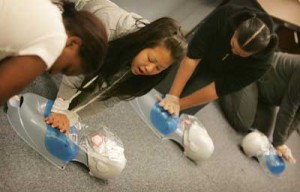 It’s an undeniable fact that cardiopulmonary resuscitation (CPR) can save lives as long as it’s done immediately and correctly. Teaching CPR is important and imparting this ability to save lives can be such a rewarding experience.
It’s an undeniable fact that cardiopulmonary resuscitation (CPR) can save lives as long as it’s done immediately and correctly. Teaching CPR is important and imparting this ability to save lives can be such a rewarding experience.
However, not everyone can teach first aid and CPR courses. If you want to teach CPR and first aid to children, you must first become a qualified instructor. The American Heart Association and the American St Mark James have certification courses on first aid. In order to pass the class, one must show proficiency in the emergency procedures, agree to follow the guidelines laid out by the authorizing organization and pay the standard fee. Certification classes to be a CPR instructor can be finished in one day, but you have to be 16 years old or older. Once you have your first aid certification, you’re ready to conduct CPR classes to children.
How to Teach CPR Classes to Children
- Preparation is the key so spend time making sure that you’re ready to give a high quality class. You can get some or all of your instructional materials or manuals from the organization that certified you. Training dummies are essential in class but can be a bit pricey. Luckily, you can rent them out or check if St Mark James or American Heart Association can supply them, along with other materials you might need. However, if these organizations can’t provide you with training dummies, you should consider working out an arrangement with your students or their parents. The cost of a training dummy plus other instruction manuals usually cost around $40 – $50 per student. Aside from these materials, make sure you have a training room that’s comfortable, well-lighted and has adequate space and facilities that you can use for 4 – 6 hours.
- Greet your students warmly and enthusiastically. Introduce yourself, point out the location of the exits and restrooms and explain your class rules. For instance, you can ask your students to turn off their cell phones as they’re a distraction or you can have your students introduce themselves. Talk about the importance of CPR, why it’s useful, how effective it is and how it works.
- Teach your students how to identify an emergency, like someone choking or experiencing a cardiac arrest. Don’t forget to discuss topics like the Good Samaritan Laws, which have been passed to protect the rights of first aid responders, how to prevent the transmission of diseases by using face shields and gloves and a quick look-over of blood-borne bacteria. Students should have a clear understanding of these topics before you can move to the next discussion.
- One great strategy for teaching CPR classes is to involve the students’ different senses. One effective way is to explain the necessary skills needed to do CPR and then showing a video of the procedure. Follow it up with a physical demonstration and then let students practice doing it. Avoid overwhelming your students with a lot of information given all at once. Practice on learning one skill (ex. looking for a pulse) before moving to the next topic.
Use this format to teach different first aid and CPR skills until all your students have shown they understand and are competent in it. Check how much they’ve learned by giving them a written and a practical test. Once that’s all done, congratulate yourself and your students for teaching and learning about an important life skill.
